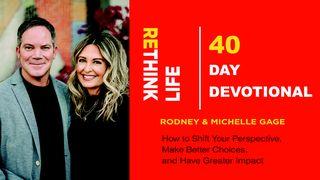Experience 14 Days of Fresh AirSample

How Can We Define the Holy Spirit?
The word Spirit is mentioned more than eight hundred times in Scripture, so obviously it’s crucial to understand its meaning and how it’s used. Our English translations use one word, Spirit, but there are actually two different words and two concepts conveyed in the original languages. In the Old Testament, the Hebrew word is ruwach, which literally means “a violent exhalation, a blast of breath, a strong wind.” We find it used in the second verse of the Bible: “Now the earth was formless and empty, darkness was over the surface of the deep, and the Spirit of God was hovering over the waters” (Genesis 1:2).
Have you ever been to a lake or pond to watch the sunrise? It’s still dark outside and there’s no wind; the surface of the water looks like glass. Then suddenly a mighty wind whips around the hillside over the water, sending ripples and waves across to the shore. This is a miniature version of what I think it must’ve been like at the beginning of Creation. God’s breath seems to be the very energy force from which he created everything—earth, heavens, animals, and of course, the first man and first woman.
In the New Testament, the Greek word for this same kind of breath is pneuma, which also conveys a breath or wind, a current of air, a strong breeze. It, too, usually gets translated into English as “spirit,” referring to the Holy Spirit, the spiritual friend who comes alongside us and empowers us with God’s presence. “The Spirit [pneuma—breath] gives life; the flesh counts for nothing. The words I have spoken to you are spirit [pneuma—breath] and they are life” (John 6:63).
So every time you read the word Spirit in Scripture, it means “breath.” Both ruwach and pneuma carry a sense of force, an active, living energy that blows in and brings life. And this is exactly what the Holy Spirit came to do—breathe new life into us.
Some people are uncomfortable with the notion of the Holy Spirit because they want something or someone they can see or touch, rather than someone they can just sense or feel on the inside. But if the best word to describe the Holy Spirit is wind, we can use this example of wind to gain a clearer, more concrete idea of who the Spirit is and his role in our lives.
Wind is something we feel and experience but don’t see. While we can observe its effects and see its impact on leaves and trees, kites and windmills, we never actually see the wind itself. Like the wind, the Spirit can’t be seen, but he can be felt, experienced, and observed in action.
When our church was still meeting at a high school, I remember standing at the door after one particular Sunday morning service, shaking hands, when a man said something I’ll never forget. When I asked this first-time visitor if he had enjoyed the service, he got a funny look on his face and said, “Preacher, there was something in that room today . . . something different.”
He didn’t know what it was—he couldn’t see it—but it drew him back the next week. Simply put, it was the presence of God. The Spirit is undeniable, real, and refreshing. It’s okay that we can feel the Spirit without seeing him. Like the wind, we can know he’s there.
The word Spirit is mentioned more than eight hundred times in Scripture, so obviously it’s crucial to understand its meaning and how it’s used. Our English translations use one word, Spirit, but there are actually two different words and two concepts conveyed in the original languages. In the Old Testament, the Hebrew word is ruwach, which literally means “a violent exhalation, a blast of breath, a strong wind.” We find it used in the second verse of the Bible: “Now the earth was formless and empty, darkness was over the surface of the deep, and the Spirit of God was hovering over the waters” (Genesis 1:2).
Have you ever been to a lake or pond to watch the sunrise? It’s still dark outside and there’s no wind; the surface of the water looks like glass. Then suddenly a mighty wind whips around the hillside over the water, sending ripples and waves across to the shore. This is a miniature version of what I think it must’ve been like at the beginning of Creation. God’s breath seems to be the very energy force from which he created everything—earth, heavens, animals, and of course, the first man and first woman.
In the New Testament, the Greek word for this same kind of breath is pneuma, which also conveys a breath or wind, a current of air, a strong breeze. It, too, usually gets translated into English as “spirit,” referring to the Holy Spirit, the spiritual friend who comes alongside us and empowers us with God’s presence. “The Spirit [pneuma—breath] gives life; the flesh counts for nothing. The words I have spoken to you are spirit [pneuma—breath] and they are life” (John 6:63).
So every time you read the word Spirit in Scripture, it means “breath.” Both ruwach and pneuma carry a sense of force, an active, living energy that blows in and brings life. And this is exactly what the Holy Spirit came to do—breathe new life into us.
Some people are uncomfortable with the notion of the Holy Spirit because they want something or someone they can see or touch, rather than someone they can just sense or feel on the inside. But if the best word to describe the Holy Spirit is wind, we can use this example of wind to gain a clearer, more concrete idea of who the Spirit is and his role in our lives.
Wind is something we feel and experience but don’t see. While we can observe its effects and see its impact on leaves and trees, kites and windmills, we never actually see the wind itself. Like the wind, the Spirit can’t be seen, but he can be felt, experienced, and observed in action.
When our church was still meeting at a high school, I remember standing at the door after one particular Sunday morning service, shaking hands, when a man said something I’ll never forget. When I asked this first-time visitor if he had enjoyed the service, he got a funny look on his face and said, “Preacher, there was something in that room today . . . something different.”
He didn’t know what it was—he couldn’t see it—but it drew him back the next week. Simply put, it was the presence of God. The Spirit is undeniable, real, and refreshing. It’s okay that we can feel the Spirit without seeing him. Like the wind, we can know he’s there.
Scripture
About this Plan

Fresh Air is about to sweep into your life. In this powerful two-week devotional, featuring a daily Scripture verse and note taken from Pastor Chris Hodges’ new book Fresh Air, you’ll be refreshed with insights on how you can revive your spirit and be fueled by God like never before. Take a breath of fresh air . . . and experience what it means to live an “I get to,” not an “I’ve got to,” kind of life every day.
More
We’d like to thank Chris Hodges and Tyndale House Publishers for their generosity in providing content adapted from Fresh Air. To learn more about the book, please visit freshairbook.com.
Related plans

Living Light in 25 Words

Change Before You Have To

Seeking God

ReThink Life: 40 Day Devotional

Finding Real Happiness: Devotions with John Piper

Live Out Your Faith with Fitness

The Daniel Dilemma

Grab the Red Phone!

God's Glory and Your Purpose: Devotions with John Piper
